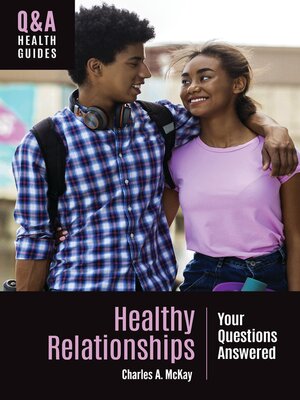
Sign up to save your library
With an OverDrive account, you can save your favorite libraries for at-a-glance information about availability. Find out more about OverDrive accounts.
Find this title in Libby, the library reading app by OverDrive.



Search for a digital library with this title
Title found at these libraries:
| Loading... |
Intended for young readers interested in creating and maintaining physically and emotionally healthy relationships, this book answers common questions and offers practical guidance on navigating such everyday issues as conflict resolution and jealousy.
Part of Bloomsbury's Q&A Health Guides series and authored by a clinical psychotherapist, this book equips readers with the knowledge and tools they need to pursue safe and meaningful romantic relationships. Although many teens and young adults are interested in dating, entering into the world
of romantic relationships can spark a number of difficult questions. This book's 46 questions address concerns related to attractiveness, readiness for a relationship, building connection and trust, conflict, sexual health, setting boundaries, and breakups:
- How do you know when you're ready to date?
- Is conflict normal, and how do you deal with it?
- What are the warning signs that a relationship is toxic or abusive?
- How do you handle a breakup and the sometimes messy aftermath?
.The text strikes a balance between theory and practice, offering clear explanations of foundational concepts in psychology and interpersonal communication, as well as useful suggestions that readers can implement in their own lives.
Augmenting the main text, a collection of 5 case studies illustrate key concepts and issues through relatable stories and insightful recommendations. The "Common Misconceptions" section dispels 5 long-standing myths about relationships, directing readers to additional information in the text. The glossary defines terms that may be unfamiliar to readers, while a directory of resources curates a list of the most useful relationship-related books, websites, and other materials. Finally, readers can turn to the "Guide to Health Literacy" section for skills and strategies for finding, evaluating, and using credible sources of health information both on and off the Internet.
Part of Bloomsbury's Q&A Health Guides series and authored by a clinical psychotherapist, this book equips readers with the knowledge and tools they need to pursue safe and meaningful romantic relationships. Although many teens and young adults are interested in dating, entering into the world
of romantic relationships can spark a number of difficult questions. This book's 46 questions address concerns related to attractiveness, readiness for a relationship, building connection and trust, conflict, sexual health, setting boundaries, and breakups:
- How do you know when you're ready to date?
- Is conflict normal, and how do you deal with it?
- What are the warning signs that a relationship is toxic or abusive?
- How do you handle a breakup and the sometimes messy aftermath?
.The text strikes a balance between theory and practice, offering clear explanations of foundational concepts in psychology and interpersonal communication, as well as useful suggestions that readers can implement in their own lives.
Augmenting the main text, a collection of 5 case studies illustrate key concepts and issues through relatable stories and insightful recommendations. The "Common Misconceptions" section dispels 5 long-standing myths about relationships, directing readers to additional information in the text. The glossary defines terms that may be unfamiliar to readers, while a directory of resources curates a list of the most useful relationship-related books, websites, and other materials. Finally, readers can turn to the "Guide to Health Literacy" section for skills and strategies for finding, evaluating, and using credible sources of health information both on and off the Internet.






